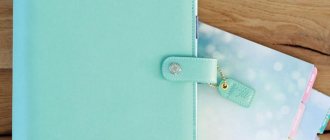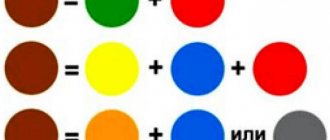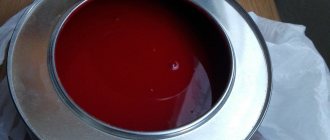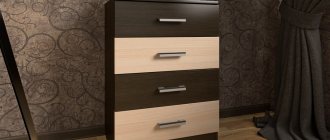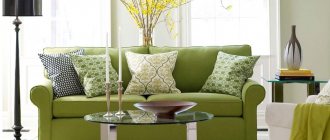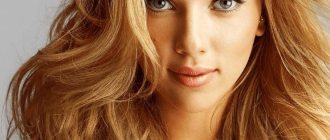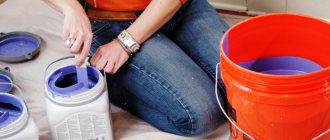Everyone knows that by combining 3 primary colors (red, yellow and blue), you can achieve any other color. This theory was developed in ancient times by Leonardo da Vinci. The conclusion from the theory can be drawn that it is impossible to obtain primary colors by mixing others. But what to do and, for example, how to get red? To solve the issue, let's approach it from a practical side and consider how red is made in a printing house, how artists get it and what needs to be done for this.
4 rules for mixing paints of different shades
- Mix similar shades . For example, medium and dark blond. For an accurate selection, use the color chart.
- Do not mix paints from different companies . Each manufacturer has its own shade palette.
- Maintain proportions . To get the desired result, you need to correctly calculate the required amount of each shade.
- Consider the drying time of the paint . Don't forget that the same color can look completely different on different hair types, and the degree of its saturation directly depends on the exposure time.
To dilute paint, do not use metal containers, only glass, ceramic or plastic.
Color Mixing Chart
Painting of surfaces should be carried out taking into account the fact that different types of lighting will change the tone of the coating. The type of red that was chosen for work also affects the result. Achieving a warm look is possible by choosing a warm scarlet from commercially available paints. You can increase the warmth by adding brown, orange, yellow. For cold, you will need a correspondingly cold scarlet.
How to make pink can be found in the color mixing table. Where are the approximate ratios of colors indicated, and what shades will be needed:
- White with red for the traditional version of pink will be obtained in a proportion of 2:1;
- Peach color is achieved by combining white, scarlet and brick. The first type takes two parts, the second two take one part each;
- Fuchsia, added to 2 measures of classic types 1 violet;
- Cyclamen is obtained from 2 parts of regular pink and adding one part of yellow;
- The dirty type will require mixing pink with 1 part gray;
- Lilac is created from standard pinkish in a 2 to 1 ratio with blue.
The ratio can only be considered approximate, because different manufacturers use different components, which leads to varying saturations.
Achieving a warm look is possible by choosing a warm scarlet from commercially available paints.
What color should be added to get shades from light to dark
There are really a huge number of shades of pink; there are more than a hundred options. The composition may contain purple, brown, orange, green and other elements that give an unusual effect. You can get a very dark type with black, dark blue, gray. Or a pale version, then a lot of white will be left, and other tones can be added for originality.
So, what colors to mix to get different types of pink:
- The traditional type, which is inspired by the rose hip shade "Rosa Canina", consists of scarlet and white;
- Cream contains a lot of white, a little red and a dash of yellow;
- Salmon comes from a soft pink with hints of orange;
- Flesh is created from the color of rose and additional white and yellow, you can make light and dark options;
- A dark shade is produced with the addition of gray; if black is chosen, then very little of it is added so as not to get dirty material.
There are really a huge number of shades of pink; there are more than a hundred options.
In what proportions should you mix hair dyes:
- The total paint consumption for short hair (up to the shoulder line) is 60 ml of paint (1 package), for medium hair - 120 ml, for long hair - 180 ml;
- To obtain the correct tone-on-tone shade, the paint is mixed with an oxidizer 1:1 (3% oxidizer is used);
- Paints of selected shades are mixed either in equal proportions, or one is taken more than the other. For example, when mixing two tones - copper and chestnut, if you want to get a shade closer to copper, then use more paint of this tone.
Now you need to find suitable shades, which is easy to do from the color chart of professional hair dyes.
Getting burgundy color
You can get a traditional burgundy color by mixing blue and red paints. To avoid turning into a purple tint, it is recommended to strictly adhere to the ratio of mixed pigments - 4 parts red to 1 part blue. It is necessary to thoroughly mix the paints until a uniform color is formed.
To obtain burgundy shades you can use:
| Blue | Reds |
| Ultramarine | Kraplak red |
| Prussian blue | Cadmium red |
| Indigo | Cinnabar |
| Azure blue | Red quinacridone |
| Cobalt blue | Iron oxide red |
| Indanthrene blue | Venetian red |
| Varnish blue | Alaya |
| Turquoise | Carmine |
| Cerulean | Kraplak pink |
A few tips for getting special shades:
- adding a small amount of light ocher will create a soft and warm undertone of burgundy color;
- replacing red paint with bright scarlet will give a rich burgundy-crimson hue;
- to obtain light and delicate undertones, the resulting color is diluted with white;
- when adding black paint to the base color, you get muted dark shades;
- a proportional increase in blue color in the color scheme will give it a deep, cold tone.
In any shade of burgundy, red should predominate. It is the basis for creating the milestone halftones of a given color scheme.
Video: how to get shades of burgundy?
When adding yellow to burgundy, care must be taken to ensure that the desired warm shade does not develop a dirty brown undertone.
These recommendations are suitable for obtaining burgundy shades when working with:
- watercolor;
- artistic gouache;
- acrylic paints;
- tempera;
- oil paints;
- stained glass paints.
Number on the package - color code
As already mentioned, making a “mix” of paints from two different brands is prohibited . After all, each brand has its own vision of caramel or ash shade. Therefore, the mixing result may be unpredictable.
But paints of the same line have their own mixing rules. They must be followed in order for you to like the result of the experiment. The first thing you need to understand is the numbers on the paint box.
Each shade is indicated by a set of numbers. The first of these is the tone of the paint, namely the level of lightness. There are 10 of them in total. The tone scale starts with 1 - the darkest, and ends with 10 - the lightest blonde. The scale from 1 to 10 includes all the variety of natural hair shades.
When is it profitable to mix colors, and when is it better to buy ready-made paint?
If the basic set of paints contains a brown tone, most likely it will turn out to be standard. Therefore, you still have to obtain the required shade by combining several different paints. But if the question arises whether it is profitable to buy ready-made paint, then we will answer: it is beneficial to have a basic set that makes it easier to obtain other shades. But, as can be seen from the article, you can even do without many paints for a while by simply combining the existing primary colors.
Don't be afraid to try, and your creativity will bring only positive emotions!
Save time: selected articles delivered to your inbox every week
Hair dye mixing technology
And now about the essence of colorism. Working with the 10-digit scale is like an artist mixing paints. A brush master can create thousands of different shades by combining just a few colors on his palette. But he knows the result in advance, so he boldly experiments with colors.
Mixing dyes is complicated by the fact that there is an initial hair color, different structure and unpredictable chemical reactions. But you can become a colorist if you learn a few rules for mixing paints.
The basis of your “creativity” should be the 10 numbers from the tone marking on the packaging. For visual reference, look at the scale from 1 to 10 with the image of dyed hair.
The base palette scale looks like this:
- 1 - maximum black color;
- 2 – brunette;
- 3 - dark brown;
- 4 – brown-haired;
- 5 - light brown;
- 6 - dark blond;
- 7 – blond;
- 8 - medium blond;
- 9 – light blond;
- 10 - the lightest blonde possible.
It is easy to understand what color you will get in the end. You need to select two tones (from 1 to 10), add their numbers and divide by 2.
Example: 8 (medium blond) + 4 (brown-haired) = 12:2 = 6
That is, you get shade 6.0 - dark blond.
Then everything is decided by the shades. They are indicated by two digits after the decimal point. The first of them is the base shade, the direction of the color. The second is depth or nuance of color. They are each subject to their own scale. It looks like this:
Shade chart
| Marking number | Hue direction (first number) | Color depth (second digit) |
| 0 | natural, slightly greenish | — |
| 1 | ashy, based on violet pigment | blue-black |
| 2 | green pigment that helps smooth out color nuances during tonal transitions | black |
| 3 | red and yellow | dark brown |
| 4 | red, copper | medium brown |
| 5 | red-violet | light brown |
| 6 | purple with blue | dark blond |
| 7 | red with brown | average blond |
| 8 | lilac | light blond |
| 9 | — | bright blond |
It happens that the tone marking has a third digit after the decimal point. It means there is a non-dominant undertone. Its content in relation to the main tone can be from 30% to 50%.
The third digit is deciphered as follows:
- 1 – ashen;
- 2 – purple;
- 3 – golden;
- 4 – copper;
- 5 – swallowtail;
- 6 – red;
- 7 – coffee.
At home I use paint from the company
Shades of burgundy in the interior
Lush classics in apartment design are often emphasized by burgundy in combination with gold. The most expensive hotels inevitably have such a range; it is also appreciated in rich houses of the East. Also, in various styles, this color is used to emphasize certain areas. For example, wine-red curtains in combination with a light veil look good. Burgundy is also appropriate for sofa covers, furniture upholstery, and decorative pillowcases.
The color sangria is used in the design of girls' rooms. It is combined with white and light pink, used for the manufacture of furniture and textile facades. In the kitchen, burgundy is combined in the interior with coffee, white, beige, and terracotta.
Examples of effective color schemes
To make your first steps in coloring successful, we offer several options for mixing colors.
- Cool natural blonde . To get this shade without green undertones, mix three paint tones of the same brand: 10.0 + 10.65 + 10.16.
- Cool light brown . Combine paints of two shades: 8.1 and 8.36.
- Copper-golden . You will need two tones - 6.4 and 6.3.
- Beige . If you make a composition of three tones: 8.76 + 8.71 + 74, you will get an unusual and beautiful caramel-brown color with an ashen nuance.
- Champagne blonde . If you're tired of expressionless blonde, you can create a multifaceted color without going beyond the light palette. To do this, you will need 4 tones at once: 10.0 + 10.117 + 10.65 + 10.116.
- Ash golden . A mixture of two shades 8.3 + 8.1 will give a total shade of 8.13 - medium blonde with a subtle ashy nuance and a dark brown undertone.
- Chocolate red . A luxurious dark chocolate color with copper tints can be obtained if you use three packages of paint with tones: 5.5 + 5.7 + 5.0.
With the help of coloring you can get rid of unwanted shades on the strands. For example, the yellowness of light brown hair is easily neutralized. If you dye your curls by mixing two light brown dyes ( of the same brand! ) - 7.1 and 7.16, then the color will be as close as possible to natural. And yellowness will be removed from the strands for a long time.
What color will you get if you mix red and green?
Typically, if you mix red and green using paints, you can get a brown tone, with the intensity depending on which shade was taken. Red color influences a secondary role: first of all, the contrast of green influences the creation.
Interesting materials:
How to measure your stride length when walking? How to measure very high voltage? How to measure distance by steps? How to measure distance in steps? How to measure current in a circuit? How to measure the humidity in a room? How to measure air humidity with a psychrometer? How to measure the humidity in a room? How to remove the card from the tachograph? How to pump up your abs to have six-pack abs?
Rules of the color wheel: what should not be mixed with what
To create all kinds of shades, colorists always use a color wheel. Despite the wide field for activity that basic colors provide, there are several taboos in colorism. And they are all associated with such a concept as countercolor. If you mix two counter-colors, you can get strange colors on the strands.
Remember, never mix with each other:
- green + red.
- purple/blue + yellow/orange.
If you mix two countercolors, unusual shades of hair may appear: orange, blue or green. Here you need to focus on the second number in the marking.
For example, if you combine green (2) and reddish-yellow pigment (3), you get green hair color. If red copper (4) is paired with green (2), it will give a bright orange color. The combination of violet-blue (6) with reddish-yellow (3) will “please” the bluish or bluish tint of the strands.
But sometimes countercolors can be beneficial. Especially in correcting unsuccessful coloring. They neutralize bad shade after hair dyeing.
For example, the yellowness of blonde hair can be easily removed with tinting agents with blue or violet pigments. And if suddenly, after experimenting with color, a greenish tint does appear, it is neutralized by copper-red (4) or red-violet (5) pigment.
Natural red
In addition to artificially obtaining color, it can easily be made from natural materials. This is how bedstraw flowers allow you to paint objects bright red. To prepare this paint, flowers are dried and boiled with alum for half an hour. Safflower and St. John's wort flowers are also suitable for making red paint by boiling water until thick. Cherry paint, similar in color, is made from orange lichen. You need to finely chop the lichen and mix it with baking soda (it is better to use a solution), wait 3-4 minutes and you can use it.
In nature, red color can be found quite often. Therefore, its different shades are sometimes named based on their natural hosts: fruits, minerals and berries. Among them you can find such names as: raspberry, pomegranate, cherry, coral, blue, wine, burgundy. All similar colors form the red spectrum.
Red shades in painting are made based on pigments of warm and cold shades. Quinacridone ruby or violet should be considered cold, and light cadmium, orange sienna (natural and burnt) should be considered warm.
RGB and CMYK color models
How to dye your hair with two colors
If you decide to conduct a color experiment, the procedure will take no more time than regular coloring. For this you will need:
- 2 containers;
- 2 packs of paint of the same brand;
- plastic gloves;
- paint brush;
- fatty cosmetic cream;
- cape on shoulders.
Painting is carried out in several stages:
- Apply the cream to the skin close to the hair growth. This way you will protect it from staining.
- Wear protective gloves and cover your shoulders with a cape.
- Mix the ingredients of the first package in a separate container. Please use the manufacturer's instructions.
- Combine the components of the second package also in a separate container according to the instructions.
- Combine the contents of the two containers together. Stir until smooth.
- Apply the solution to your hair immediately.
- Allow time according to the instructions, then wash off the paint and treat with a caring balm.
- Do not forget that you cannot store the paint solution. It must be used up immediately. Leftovers are not left until next time. They cannot be stored. Strictly adhere to the dyeing time. It is indicated in the instructions. For paints from the same company in similar tones, it should match.
If you are not sure of the final result, then it is better to contact an experienced colorist.
Will folk remedies help?
If you want to slightly lighten the red and make it duller, closer to natural, then folk remedies will come to the rescue. But they only slightly lighten the main tone, and they need to be used often.
Recipes:
- Lemon juice. Squeeze it out and use it to rinse your hair or apply masks. In the second case, to enhance the effect, cover your head with film and leave the product for half an hour to an hour.
- Fermented milk products: the more sour, the better. They contain lactic acid, which, like all fruits, destroys pigments and has whitening properties. Kefir or yogurt can be used daily in the form of masks.
- Baking soda. There are several possible uses. The first is rinsing with a solution (a tablespoon of powder per glass of water). The second is applying a slurry prepared from water and soda. The third option is to add soda to shampoos before washing your hair.
- Cognac (or any other strong high-quality alcohol) with vegetable oil. Apply the mixture, consisting of equal parts of the components, along the length of the curls and leave for an hour. The procedures are carried out daily for visible results within a week or two.
Eliminating red hair is not easy, but it is possible, especially if you know and use truly effective methods!
Tips before coloring
A few tips will help you improve your coloring results and achieve the desired shade:
- A week before coloring, do not apply caring balms and masks . They envelop the hair. Therefore, they will prevent the penetration of pigment.
- Before painting, I don’t wash my hair for several days . This way you will be able to reduce the harmful effects of the oxidizing agent.
- Apply the dye to dry strands . Wet hair will dilute the pigment. The shade may be less saturated.
- Choose tones that are close in scale . Then the result will be more predictable. Leave complex color experiments to the specialists. After all, colorism is real alchemy. Mastering the science of color mixing takes time.
Mixing hair dyes yourself is quite risky. To obtain a successful color, it is better to trust an experienced stylist, however, if you lack confidence in your own abilities, you can experiment. The main thing is to carefully read the article again and take the rules for mixing different shades of paint as responsibly as possible.
If you dyed your hair with tonic
If the red is the result of staining with tonic, then this simplifies the process of transitioning to another color. But it will be possible to return to natural, although after this it will be possible to experiment again.
There are specialized shampoos on sale for washing off tonics: within a week they practically remove all pigment from the surface of the hair shafts. You can also use deep cleaning shampoo twice a week. If you have time, just wash your hair more often with regular shampoos: the tonic will gradually wash off.
Tinting components are well neutralized by oils. Oil masks, by the way, are good for hair, so feel free to do them. You can apply olive, linseed, sesame, and corn oil to your curls daily or every other day. It is kept for an hour under the film, after which it is thoroughly washed off.
Tips for choosing paint
Above we have already discussed shades of garnet color and the dye numbers that allow you to get them. Indeed, for an expressive, but at the same time as natural result as possible, it is worth choosing a professional dye. In this case, your curls will look very harmonious in combination with your image, facial features and makeup, even though their color is completely unnatural.
But if your goal is to achieve a bright garnet or red color, then it is best to choose a dye from the line of extreme cosmetics. The result is incredibly bright, rich hair that has exactly the undertone you chose. The main thing is that you can apply makeup with such beauty products at home – simply and without any fuss. The garnet color scheme is widely explored in dyes called Manic Panic. You can choose a shade with cool undertones - Red Passion (number 11050), with a warm undertone - Pillarbox Red (number 11020) or just a bright red called Wildfire and number 11010.
About primary colors: how to get red
Johannes Itten spoke about the existence of three colors, without which it is impossible to mix. Obtaining different shades is possible thanks to three:
- yellow;
- blue;
- red.
Red is one of the basic colors, so it is impossible to artificially obtain it from other colors. In computer graphics, such a trick is still possible - you need to combine orange and lilac colors (yellow and lilac). Combinations of yellow + magenta or orange + magenta can produce a red pigment. Pink is not exactly magenta, because magenta is formed when red is combined with purple. By adding one or another shade of two non-primary colors, a color close to red is obtained. This method doesn't work in real life. You can get a color close to red using this method only in a graphics editor.
If we talk about the palette in reality, red is its most important component. There are secondary colors that are obtained by combining primary colors. This:
- orange (yellow + red);
- green (yellow + blue);
- purple (blue + red).
Who is it suitable for?
There is an opinion that garnet hair color is the prerogative of mature and elderly ladies. They say the shade perfectly hides gray hair, makes you look a little younger and gives you a fresh look. Therefore, it is believed that it is not appropriate for young people to use it. In fact, a well-chosen shade of this color scheme is a guarantee of success and harmony of the image. If the tone matches the natural color, then your appearance will become much brighter, more expressive and original, but not at all vulgar or even older. Take a close look at the photos of garnet-colored hair and the models who wear it. Even on the youngest girls, the color looks fresh, laconic and harmonious.
Well, now we will find out what shades exist in this palette and which of them should or should not be chosen for this or that color type.
In cold colors
For representatives of summer color, garnet hair color was initially contraindicated. Such a rich and expressive color scheme absorbed the delicate and tremulous appearance and made the image extremely inharmonious. Nowadays, “summer” young ladies can afford to wear a cool garnet hair color and not worry that it will introduce an imbalance into the image. It is only important to remember that such a color scheme should completely lack copper and golden pigments. Also, the depth of tone cannot be lower than 6. Many stylists believe that this shade ideally emphasizes a pale and delicate appearance, making it non-standard and expressive.
Again, painting your home in platinum tones is a thankless task. The result may not be what you expect, and “ominous” yellow or redness will sooner or later appear on the surface.
Lightest tone
Girls whose appearance is naturally light, and sometimes even pale, cannot afford to dye their hair a very dark, much less a bright and rich shade. Otherwise, the hair will literally “absorb” the face, making it nondescript and unnoticeable. But especially for those who have just such an “innocent” flavor, but at the same time want to look bright and catchy, stylists have developed a unique paint. This is a garnet tone that has a very shallow color depth, it is rich, but at the same time it seems translucent and light. If you choose this shade with a cool undertone, it will be an excellent solution for a representative of the summer color type. But if you rely on a warm undertone, this will be a real find for the “spring girl”.
To choose the right dye for a similar result, you should pay attention to those tubes whose tone depth is 7 or 8. In the “Kapus” Palette it can be 7.62 paint, in the “Estelle” palette – 8/5 or 7/5.
What shade is this?
You definitely won’t find garnet hair color in the natural color palette. It is beyond platinum, gold and even beyond copper tones. The color is extreme, such hair does not exist in nature, and that is why it is so original, attractive and non-standard. Many believe that the name of the shade comes from the fruit of the same name, the fruits of which have a slight pinkish tint. But in fact, garnet hair color is named after the stone, which is most often called ruby. This is how it is - burgundy-raspberry, rich, deep with dark tints and an unearthly glow. Separately, we decided to note that the so-called pomegranate palette has several shades. They differ from each other in depth and their ebb. Below we will take a closer look at this issue.
Who should categorically refuse the garnet shade?
In this section we will not talk about a specific color type; fortunately, we have already found out that this tone is universal. But there are some cases when it is advisable to abandon such a bright and attractive color scheme. If the skin has imperfections - these could be redness or protruding blood vessels, then garnet-colored hair will only highlight them. Also, in cases where the skin has a pronounced pink undertone, stylists recommend not dyeing your curls in a ruby tone - it will cause a painful appearance.
Some masters also do not recommend that their clients, who are still very young, turn their curls the color of ruby stone, as they believe that this tone is very mature and age-related. But in fact, a well-chosen shade is the guarantee that the image will be appropriate and harmonious, and neither age nor social status has anything to do with it.
Varieties of Bordeaux
There are different shades of burgundy, some shades have more lilac or violet, this is a soft shade. The dark burgundy color looks very impressive. The shade of carmine is delicate, often used in art, as well as to create an elegant interior. Falun burgundy is a version of a dark shade that is most often used in renovation and construction.
Maroon color is often confused with chestnut. This is also a natural shade of burgundy. It differs from the classic one in its depth and unusualness. There are varieties such as pomegranate, mahogany, wine, ruby, orchid, strawberry jam.
Bright burgundy is energetically strong, it attracts attention, gives confidence, and attracts risk. The fashion for Bordeaux is due to the fact that it personifies respectability, wealth, a high standard of living, and expensive surroundings. Allows you to stand out, stun and emphasize your high status.
Getting pink is just as easy.
